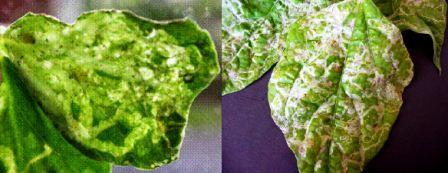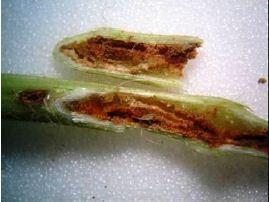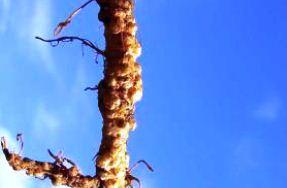Rajmash: Insect and Mite Management
Rajmash: Insect and Mite Management
Leaf miner
Biology:- Egg: Eggs are minute in size and orange yellow in colour. The egg hatches in 4 days.
- Maggot: Apodous maggot feeds on chlorophyll mining in between epidermal layers. Full grown maggot measures 3 mm and duration is about 7 days.
- Pupa: Pupation takes place inside a thin loose mesh of silken cocoon either in soil or in leaves. Pupal period is about 7 days.
- Adult: It is a pale yellowish fly, measuring 1.5 mm in length. The female fly punctures upper surface of leaf to lay eggs singly. Total life cycle is completed in 3 weeks.

- Leaves with serpentine mines
- Dropping and drying of leaves in severe cases
- Warm weather conditions are favourable for multiplication.
- Parasitoids: Gronotoma micromorpha, Diglyphus sp, Halticoptera circulus and Opius sp, Chrysocharis sp, Neochrysocharis formosa (Westwood) etc.
- Predator: Lacewings etc.
Gram pod borer
Biology:It is a Polyphagous pest, infesting gram, lablab, safflower, chillies, groundnut, tobacco, cotton etc.
- Egg: Ovall, sculptured, yellowish eggs are laid singly on tender plant parts and buds. The egg period lasts for 2-4 days.
- Larva: Caterpillars are of varying colour, initially brown and later turn greenish with darker broken lines along the side of the body. Body covered with radiating hairs. When full grown, they measure 3.7 to 5 cm in length. The larval period lasts for 18-25 days.
- Pupa: Pupation takes place inside the soil in an earthen cell. Pupal stage lasts for 7-15 days.
- Adult: Moth is stout, medium sized with brownish/greyish forewings with a dark cross band near outer margin and dark spots near costal margins, with a wing span of 3.7cm.

- Early instar larvae scrap the chlorophyll of the leaves
- Mature larvae head bore inside the pods and the rest of the body remain hanging out.
- Pods with irregular big holes
- Parasitoids: Carcelia sp., Campoletis chlorideae, Ichneumon promissorius etc.
- Predators: Chrysoperla zastrowi sillemi, coccinellids, King crow, braconid wasps, dragonfly, spider, robber fly, reduviid bug, preying mantid, and red ants etc.
Aphids
Biology: Eggs: Eggs are very tiny, shiny-black, and are found in the crevices of bud and stems, of the plant. Aphids usually do not lay eggs in warmer parts of the world.
Eggs: Eggs are very tiny, shiny-black, and are found in the crevices of bud and stems, of the plant. Aphids usually do not lay eggs in warmer parts of the world. - Nymphs: Nymph (immature stages) are young aphids, they look like the wingless adults but are smaller. They become adults within 7 to 10 days. Viviparity is also observed
- Adults: Adults are small, back to dark brownish colour, 1 to 4 mm long, soft-bodied insects with two long antennae that resemble horns. Most aphids have two short cornicles (horns) towards the rear of the body.
- Nymphs and adult aphids suck plant sap from leaves, shoots, buds and floret.
- In addition, plants may become contaminated by honeydew produced by aphids and sooty mould growing on honeydew.
- Rajmash contaminated with honeydew and / or sooty moulds are not marketable.
- Aphids are also vectors of diseases, including the common bean mosaic virus.
- The black bean aphid is a widely distributed pest of beans. The black legume aphid usually attacks beans grown at low altitudes
- Parasitoids: Aphidius colemani, Aphelinus sp
- Predators: Fire ant, Robber flies, Big-eyed bug (Geocoris sp), Earwig, Ground beetle, Cecidomyiid fly, Dragon fly, Preying mantid, Lacewing, Ladybird beetle, Spider, syrphid fly etc.
Stem fly
Biology: Eggs: The stem fly inserts eggs on the underside of young leaves. Ovipositing sites show pale pinprick spots when infested leaves are held against the light.
Eggs: The stem fly inserts eggs on the underside of young leaves. Ovipositing sites show pale pinprick spots when infested leaves are held against the light. - Maggot: Whitish, torpedo-shaped maggots measures about 2mm.and they pupate after 8-11 days inside the stem. Before pupation, the maggot makes an exit hole for the emergence of the adult.
- Pupae: Pupae are smooth, light brown to pale brown, cylindrical in shape with rounded ends. Pupal stage lasts for 6–12 days.
- Adults: Adult flies are shiny black and about 2mm long with a pair of clear wings with a wingspan of 4-5 mm.
- Infested stems are often red inside (sometimes pale) and a distinct zig-zag tunnel may be observed — with maggots or pupae inside. Apart from the exit holes, the plants will initially appear healthy on the outside.
- Heavy infestations (3 or more maggots per plant) may cause wilting and even death of the plant, especially in younger one particularly if damage occurs in the plant’s hypocotyle (basal stem) region.
- Parasitoid: Tiny wasps
Root knot Nematode
Biology: Most species of plant parasitic nematodes have a relatively simple life cycle consisting of the egg, four larval stages and the adult, male and female.
Most species of plant parasitic nematodes have a relatively simple life cycle consisting of the egg, four larval stages and the adult, male and female. - Development of the first stage larvae occurs within the egg where the first moult occurs. Second stage larvae hatch from eggs and infest plant roots or in some cases foliar
- Infested plants appear in patches in the field
- Formation of galls on host root system is the primary symptom
- Roots branch profusely starting from the gall tissue causing a ‘beard root’ symptom
- Infected roots become knobby and knotty
- In severely infested plants the root system is reduced and the rootlets are almost completely absent hampering their function of uptake and transport of water and nutrients.
- Plants wilt during the hot part of day, especially under dry conditions and are often stunted.
- Nematode infestation predisposes plants to fungal and bacterial root pathogens.
- Primary: Egg masses in infested plant debris and soil or collateral and other hosts like Solonaceous, Malvaceous and Leguminaceous plants act as sources of inoculums.
- Secondary: Autonomous second stage juveniles that may also be water dispersed.
IPM for Rajmash
To know the IPM practices for Rajmash, click here.
Source: NIPHM and Directorate of Plant Protection, Quarantine & Storage
Last Modified : 12/11/2019
© C–DAC.All content appearing on the vikaspedia portal is through collaborative effort of vikaspedia and its partners.We encourage you to use and share the content in a respectful and fair manner. Please leave all source links intact and adhere to applicable copyright and intellectual property guidelines and laws.
RELATED ITEMS
Broccoli Insect Pests
This topic covers information about Broccoli Ins...
Ber Insect and Mite Pests
This topic covers information about Ber Insect and...
Pea Insect Pests
This topic covers information about Pea Insect Pes...
Amla Insect Pests
This topic covers information about Amla Insect Pe...
